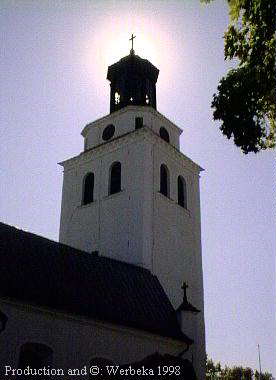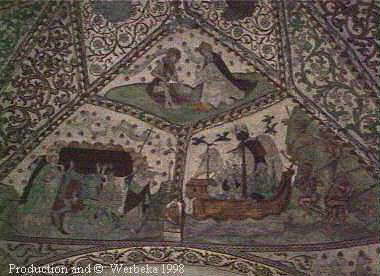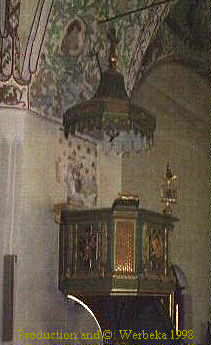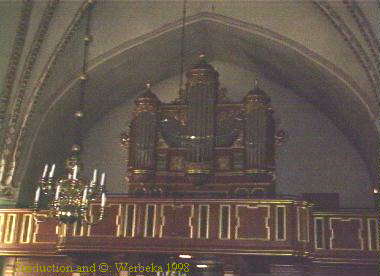
 .
.
THE CHURCH OF DINGTUNA
© Bernhard Kauntz, 1998
Dingtuna is situated west of Västerås, just outside of the city-border, on the old road heading to Köping/Eskilstuna.
The church, on the "other side" of road and railroad, dates back a very long time. The building of today was raised in the 14th century, but it is known, that two centuries earlier there was an older church in Romanesque style. Findings of burnt timber benearh it might indicate a still older wooden church.
Today the area of the church is 31,7 x 13,2 meters, which is still the same as it was in the 14th century, when the church was built. In the 15th century the tower was raised, as well as brick-vaults inside, to strenghten the architecture. In the 18th century the building showed massive signs of decay, as many churches did at that time. In 1735 they the western vault, which had fallen down, was to be repaired entirely. And through the following years there was a general restoration to be done.
The next restoration, in 1898, was in the hands of Erik Hahr, born in Dingtuna, but most well-known because of his occupation as municipal architect in Västerås.
The most important sight in the church of Dingtuna are doubtless the wall-paintings from the 15th century. Those are the early work of Albertus Pictor, one of the best known church-decorators of his time. Of course Albert employed a lot of assistants, as did all the great maters, so one can't be sure how much of the paintings Albert produced himself. Often the master concentrated on the essentials, whereas the assistans did the decorating. On the other hand the Dingtuna paintings are from the beginning of his career, so maybe he didn't have that many assistants yet.
 On the image (showing the southern part of the vault) you can see John the Baptist and St. Antonius; below to the left the death of Mary, the disciples carrying her bier. Down to the right you can see the sailing of St. Olof. Indeed the church of Dingtuna was dedicated to Virgin Mary and St. Olof.
On the image (showing the southern part of the vault) you can see John the Baptist and St. Antonius; below to the left the death of Mary, the disciples carrying her bier. Down to the right you can see the sailing of St. Olof. Indeed the church of Dingtuna was dedicated to Virgin Mary and St. Olof.
One must remember that all of this happened before Gustav Vasa and the reformation, that is to say, still in a catholic country. Therefore it isn't so surprising, that, when the church was repainted in 1649, all of Pictor's art was overpainted. At the restoration in 1898 the walls were cleaned and the old paintings behind restored as close as possible to their original form. A lucky discovery at the restoration in 1968 showed that the saturation of the colours was underestimated in 1898.
 
Behind the pulpet there was found an original painting of St. Michael and the dragon, which never had been overpainted, because it was hidden of the pulpet's back. This is due to the lucky circumstance that the predecessor of today's pulpet was installed in 1646, that is three years before the repainting of the church. This old pulpet was replaced in turn with that on the image in 1788, made by "a man from Dalecarlia from the parish of Mora" and painted by P Hedendahl from Säter.
One of the newest inventories is the organ from 1978. Its front was designed by Erik Hahr in 1898. The two bells in the tower are from 1898 as well, but regrettably the old bells were destroyed at that time.
Since 1990 there are four tablets hanging in the porch, showing the names of all the vicars, assistants, wardens, organ-players and cantors throughout the centuries. This is not only outstanding, but also a lead from todays church to its more than 600 years of history.
Back to the  or to the
or to the  of of 
last update: 5.9.1998 by
webmaster@werbeka.com
|

 .
. or to the
or to the  of
of 
 On the image (showing the southern part of the vault) you can see John the Baptist and St. Antonius; below to the left the death of Mary, the disciples carrying her bier. Down to the right you can see the sailing of St. Olof. Indeed the church of Dingtuna was dedicated to Virgin Mary and St. Olof.
On the image (showing the southern part of the vault) you can see John the Baptist and St. Antonius; below to the left the death of Mary, the disciples carrying her bier. Down to the right you can see the sailing of St. Olof. Indeed the church of Dingtuna was dedicated to Virgin Mary and St. Olof.
